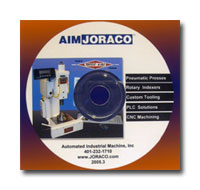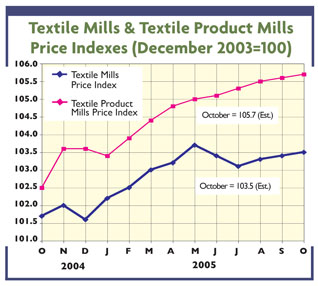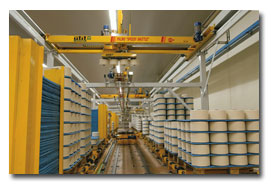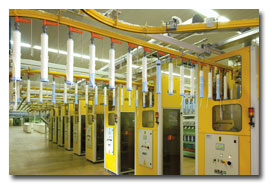Textile manufacturers and end-users alike have been searching for ways to improve the surface properties of natural and man-made fibers.
Specifically, there is a need to improve adhesion, wettability, printability and dyeability; as well as to reduce material shrinkage. Methods of modifying fiber properties to make polypropylene (PP) dyeable, including the process of copolymerization with polymers that can be dyed, have been evaluated. Traditional latex systems and primers with low melt points have been used to coat fabrics to promote ink adhesion, heat-sealing and thermoforming performance. PP nonwovens have especially been the focus of research to enhance colorfastness properties for the material because of its excellent chemical resistance, high melting point, low cost and adaptability to many fabrication methods. To date, the poor dyeability of PP has limited optimization of its applications in the manufacturing of yarns and knit fabrics, upholstery fabrics and industrial fabrics.Fibers with polar functional groups can be dyed more easily than nonpolar fibers because polar groups will chemically bond with dye molecules. Because the molecular chains of PP are nonpolar and its surface is hydrophobic, the dye molecules will not bond chemically to the fibers. PP fiber is highly crystalline as well, which also restricts its dyeability. Functional groups may be introduced onto the fiber surface by using gas plasma treatments, improving fiber surface properties without affecting the fiber’s bulk properties. By creating a polar layer on the fiber surface, in reaction with functionality introduced, wettability of the fiber for dyeing is enhanced with hydrophilicity.
A novel atmospheric plasma treatment (APT) process has been developed using atmospheric plasma glow discharge (APGD) technology as a result of studying the reaction mechanisms between plasma and fiber surfaces to optimize industrial system applications. The APT apparatus does not
require any vacuum systems, produces a high-density plasma and provides treatment of various nonwoven substrates at low temperature while operating at atmospheric pressure. The wettability of various man-made and natural fibers has been dramatically increased by this process. Electron microscopy has shown the surface of fibers after APT is uniform and consistent, suggesting the treatment is homogeneous. APT has a cleansing effect that removes contaminants and increases the microroughness of the fiber
(See Figure 1).
Figure 1: Plasma enhances the microroughness of fibers.
APT Process
Plasma is an ionized form of gas and can be created using a controlled level of AC or DC power and an ionizing gas medium. It is an ensemble of randomly moving, charged atomic particles with a sufficient particle density to remain, on average, electrically neutral. Plasmas are used in very diverse applications, ranging from manufacturing integrated circuits used in the microelectronics industry through treating polymer films to the destruction of toxic waste. Plasma processes can be grouped into two main classes — low-density and high-density — according to their electron temperature versus electron density. In low-density, direct-current and radio-frequency glow discharges, the electron and heavy particle temperatures are not equal. Low-density plasmas have hot electrons with cold ions and neutrals. Energetic electrons collide with, dissociate and ionize low-temperature neutrals, creating highly reactive free radicals and ions. These reactive species enable many chemical processes to occur with low-temperature feed stock and substrates.
Well-known types of plasmas encountered in surface treatment processing techniques typically are formed by partially ionizing a gas at a pressure well below that of the atmosphere. For the most part, these plasmas are weakly ionized, with an ionization fraction of 10-5 to 10-1. Electron cyclotron resonance (ECR) plasmas can have higher ionization at high power. Because these systems are run at low pressures, vacuum chambers and pumps are needed to create and contain these plasma processes.
The atmospheric plasma system allows creation of uniform and homogenous high-density plasma at atmospheric pressure and at low temperatures using a broad range of inert and reactive gases.
The APT process treats and functionalizes material surfaces in the same way as the vacuum plasma treatment process on a wide range of materials; and has unique advantages over the presently used corona, flame and priming treatment technologies. APT production equipment testing has been successfully performed for the treatment of various materials, including PP fiber, PP and polyethylene (PE) nonwovens, polyester fiber, Tyvek®, nylon, wool, textile yarn, oriented PP film, PE film, PE teraphthalate (PET) film and polytetrafluoroethylene film. The surface energies of the treated materials increased substantially (without any backside treatment), thereby enhancing their wettability, printability and adhesion properties.
Figure 2: A driving roll moves textiles into plasma treatment between two electrodes one is the grounded roll, and the other is the powered electrode with gas inlets.
If APT produces a uniform discharge between electrodes, the system is defined as an APGD system. In the case of a nonuniform discharge, the system is known as a corona treater. Schematically, a system to treat films or textiles at atmospheric pressure has the structure of that shown in Figure 2 — from a feed roll, films are driven by the grounded roll in the plasma treatment and then to a collector. Plasma is produced between two electrodes — one is the grounded roll, and the other is the powered electrode connected to a high-voltage frequency power supply. In the case of a corona treater, plasma is developed in air. In the APGD system, the electrode is connected to gas inlets.
A standard corona treater and an APGD system with proprietary designed electrodes were used for these investigations. A dielectric layer between the electrodes and an appropriate gas mixture as the plasma medium are used to obtain a uniform discharge
(See Figure 3).
Figure 3: There is uniform and homogenous plasma discharge with an atmospheric plasma
surface treatment system.
Treatment ResultsOn Printing Of PP Nonwovens
Several PP nonwovens with a 0.40-mil thickness were treated by the plasma treater at atmospheric conditions. These nonwovens were treated on webs ranging from 27 inches to 60 inches in width. The key treatment parameters were input power, gas type, flow and the ratio of the gas mixture.
APT was performed with both APGD and corona systems evaluating the surface tension variation in the samples. Surface tension of the treated nonwovens was determined by ASTM D-2578 surface tension test fluids markers. The surface energy of these nonwovens was enhanced substantially after the plasma and corona treatments. The initial surface tension level was measured at 31 dynes per
centimeter (dynes/cm). The surface tension was increased to 52 dynes/cm using the APGD reactor with an oxygen/helium plasma, and to 52 dynes/cm using a corona treater.
The mixture gases for APGD included helium and oxygen at flow rates of 14 liters per minute (lpm) and 2 lpm, respectively. The treatment times for APGD and corona were both at 0.48 meters per second. The input power was 1 kilowatt, and the operating frequency 80 kilohertz. The nonwovens then were printed with an image of the American flag in a four-color process using photopolymer printing plates on a Mark Andy press with Akzo Nobel Hydrokett 3000 water-based ink. The anilox roll was a 700-line screen with a 2.1-cell volume. The nonwoven material was printed in roll form at 60 meters per minute. The ink was dried in-line using forced air at a temperature of 140°F. Untreated, corona-treated and plasma-treated protocols for these nonwovens then were evaluated to determine the adhesion of the ink.
A tape test was performed for each protocol using a 1-inch by 2-inch tape peel test in which fresh, transparent pressure-sensitive tape was applied to the printed side of the film for 60 seconds. The untreated and printed nonwoven exhibited total ink adhesion failure. The corona-treated nonwoven retained approximately 90 percent of the image ink at its surface. The APT-treated nonwoven displayed approximately 100-percent ink adhesion. The trial supports the role and efficiency of atmospheric plasma in functionalizing the surface of PP nonwovens for improved water-based ink adhesion. A second test was performed to assess the holdout of the ink from the nonwoven fiber structure. Since absorption of ink into printed substrates can diminish the surface perception of the pigments used, promoting ink holdout on printed substrates can serve to increase the depth of color within the image. A comparison was made of untreated, corona-treated and plasma-treated PP nonwoven material relative to the reflectivity of light off of the aforementioned four-color process image using a spectrophotometer. The plasma-treated nonwoven demonstrated a significant increase in the reflectivity of the flag image’s primary blue and red tones, beyond the reflectivity created by the untreated or corona-treated nonwoven. Additional APT trials on spunbond PET nonwoven materials utilizing gas chemistries have led to improved dyeability using water-soluble inks and dyes. Although not a direct predictor of pigment adhesion, dye levels of greater than 70 have been achieved for spunbond PET nonwovens.
Surface Transformation
The gas phase and surface kinetics during APT of PP and the resulting modification of its surface properties also have been investigated. Gas temperatures and relative humidity were held constant during all trials. Fourier Transform Infrared Spectroscopy measurements indicate plasma treatment of PP involves free-radical bombardment that introduces oxidized functional groups onto the surface and may include methanol/alcohol, ketone, carboxy, ether, epoxy, ester or hydroperoxide. This is in agreement with previous observations reporting the addition of oxygen at the surface of PP. Grafting of nitrogen, observed in treatments with helium plasma because of the presence of nitrogen molecules efficiently excited by helium in the discharge, is supposed to be hindered here by the oxygen amount in the plasma.
The chemistries formed under the action of the glow discharge are responsible for the change
in the polymer surface properties. Moreover, increasing energy deposition increases the densities of carbonyl, acid and peroxy radicals on the PP surface. For a given energy deposition, higher web speeds also resulted in decreased concentrations of peroxy radicals, carbonyl and acid groups on the PP surface.
Enercon Industries Corp.’s commercial atmospheric plasma treatment system functionalizes a
nonwoven web surface.
Conclusions
APGD can be operated at low temperatures and at atmospheric pressure, thereby eliminating the need for any vacuum chambers or pumps. Yet, it provides the unique advantages that plasma technology has over existing technologies for surface treatment of nonwovens. The systems used for investigation are all commercial devices, confirming the possibility of using APT systems in industrial places.
The surface energies of the nonwovens treated using APT have been shown to increase substantially, significantly enhancing the wettability, printability, dyeability and adhesion properties of these nonwovens. Furthermore, tape peel tests indicate the APT process can effect better ink adhesion than corona treatment. Ink holdout on PP nonwovens, printed with water-based ink and measured by wavelength reflectivity, has been shown to be improved when compared to the same nonwoven processed using
corona treatment.
Editors Note: Rory A. Wolf is vice president, business development, at Menomonee Falls, Wis.-based Enercon Industries Corp. Amelia Sparavigna is assistant professor, physics department, at the Italy-based Polytechnic of Turin.
November/December 2005

 Portsmouth,
Portsmouth, Smithfield,
Smithfield,











